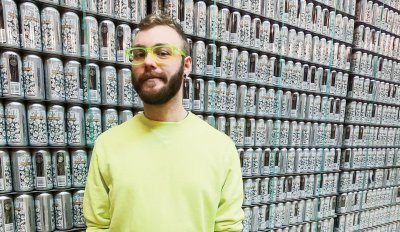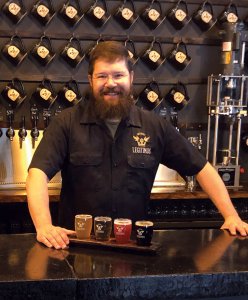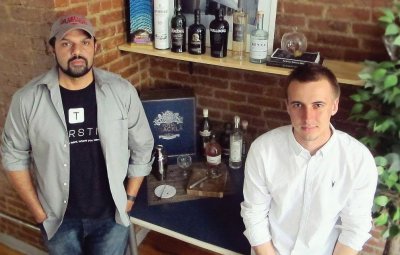Feature Story

The joys and challenges of running a brewery, creating a tasty wine, and delivering spirits

Amy Prosenjak ’94 never imagined she’d leave the Midwest to become the CEO of an Oregon winery. The OWU accounting major had worked 14 years for two very traditional Ohio companies—The Limited and Value City Furniture—and had grown up in Youngstown, Ohio.
Owen Ridings ’06 had a similarly unexpected experience. He had toiled for the forest service in the West and marketed automobiles in Detroit before realizing that wine was his calling.
But as craft breweries sprang up like weeds, wine-tasting tours became popular getaways, and whisky sours and martinis had a resurgence, Prosenjak, Ridings, and other OWU graduates learned there’s much to love—and little to hate—about the alcoholic beverage industry.
We’re farmers, and all of these vineyards have to deal with the climate.

“It’s a unique combination of art and science,” says Roger Nabedian ’85, senior vice president and general manager of E&J Gallo Winery in Modesto, Calif. “There’s an art to creating wine, but it’s also a scientific endeavor. At its core, wine is a consumer product, and that makes the business very complex. And I like the complexity.”
Nabedian’s been with Gallo since 1986, just a year after he graduated from OWU with a chemistry degree and a yen for a job that wasn’t staid and predictable. Today he manages Gallo’s $1.2 billion premium wine division and is part of the leadership of the family-owned company. He’s grown to appreciate the benefits of a company founded and owned by family, as many are in the industry.
“I didn’t think about this when I joined the company, but once you’re there and you interact with the more senior level staff, you realize that the purpose and values of the company are likely to remain consistent,” he says. “That gave me the confidence that I knew what was likely to happen in the company, and I was motivated to work hard because of that.”
There’s an art to creating wine, but it’s also a scientific endeavor.

Bennett Thompson ’12 also majored in chemistry at OWU, but he’s used his degree in a more direct way: He’s a quality manager for Half Acre Beer Co., in Chicago, where he tests the brewery’s beer at various points in its production to make sure it’s a consistent product.
“Beer and beer science are really understudied,” says Thompson, who also has a master’s in chemistry from Yale University. “We’re just beginning to learn what causes different flavors and how to really wrangle with what beer is. That’s pretty cool, and I like to be able to sink my teeth into that.”
We’re just beginning to learn what causes different flavors and how to really wrangle with what beer is. That’s pretty cool.

Chris Sayer ’99 considers his leap into owning his own brewery in New Hartford, Conn., “a chance to put my artistry into a glass for you to enjoy.”
He and his wife, Christina, opened Brewery Legitimus in 2016 in a former Waring factory on Rt. 44 after three years of planning. Besides brewing craft beers such as an IPA called Dr. Strangehaze, they run a taproom that Sayer likens to an old-time pub in England or Scotland.
“I love what I do,” says Sayer, who majored in politics and government and international studies at OWU. “If you love what you do and can balance those things in your life, that’s success. Most people never discover what they’re passionate about, and I feel fortunate that I found that.”

Devaraj Southworth ’94 also comes to the field with an entrepreneur’s passion but a different bent: enabling home delivery of spirits within an hour or two. A myriad of federal, state, and local laws make such deliveries complex. Spirits can’t be sold directly from a manufacturer to a consumer; they must go through a distributor and a retailer.
“It’s a tough industry and extremely challenging,” says Southworth, who started his business six years ago with fellow OWU alumnus Maxim Razmakhin ’10. “Part of my joy is taking the time to see how we can work to make this industry more efficient. Consumers in this day and age want to make purchases for everything on their mobile devices.”
The business has evolved from one that facilitates home deliveries to a company that now provides marketing and data for manufacturers so they can know their customers better, Southworth says. He’s banking that will increase the percentage of liquor sold online, now at less than 1 percent, to a figure closer to the general online purchase percentage of 13 to 14 percent.
While government regulations for wine and beer sales aren’t as stringent as for spirits, the businesses have plenty of unique challenges.
“It’s highly competitive,” says Prosenjak, who has worked for A to Z Wineworks in Newberg, Ore., for 13 years. “It’s difficult as a business to get attention, so we’ve invested in marketing, buildings, and salespeople.”
That’s meant steady growth. Prosenjak notes that A to Z produced 80,000 cases of wine a year when she started; that’s ballooned to 400,000 cases a year, sold in all 50 states and exported internationally.
According to Nabedian, drinking wine came of age in the United States with baby boomers in the 1980s and 1990s.
“Forty or fifty years ago, the United States was a whisky-drinking culture,” he says. Household penetration for wine has grown significantly, from 20 to about 40 percent, and the trick now, he says, will be to make wine an everyday part of meals.
“It’s a huge opportunity, but also a major challenge.”
Exacerbating that challenge is climate change, says Prosenjak.
“We’re farmers, and all of these vineyard owners have to deal with the climate.” That has included a six-week swing in harvesting grapes because of climate change, she says.
Ridings, a wine sales specialist at Chateau Potelle winery in California’s Napa Valley, believes climate change will affect wineries more than anything else in the coming years.
“But we can adjust to the climate we’ll be in,” he says. “If all technology went away, we could still produce wine, and still produce great wine. You’re at the mercy of Mother Nature, so you make adjustments and have contingency plans.”
Prosenjak also worries about a dwindling supply of skilled labor, which she says is caused by the government’s squeeze on immigration and the growing cannabis market.
“It’s the same labor pool we’re drawing from at the same time of the year,” she says. “When grapes or anything are ready to harvest, you have to harvest them, and pruning and harvesting in a vineyard is really skilled labor.”
In the craft brewery industry, competition may be the biggest challenge, according to Sayer.
“We constantly have new competitors,” he says. “Some later entrants think owning a brewery is a license to print money and it’s easy. But we work 80 to 100 hours a week.”
Others “have an obsession with always making something new instead of just perfecting what they’ve already created,” Sayer adds. “Staying relevant and making beer your customers want is important. There’s going to be a correction in the market eventually, and those that fall through will be those that haven’t connected with their customers and haven’t developed a culture to go along with their brand.”
Thompson, of Half Acre Beer, also anticipates fewer craft brewers as some consolidate or run out of capital. That may come about, in part, as brewery workers demand better pay.
“Breweries tend to run lean, and wages are depressed,” he says. “I’m well taken care of, but some breweries with a national status have taken advantage of the fact that it’s a cool job. So for a lot of people that means hopping from one brewer to another. It’s definitely something we need to collectively wake up to.”
The best breweries, he says, have a strong commitment to consistency and quality no matter what type of beer they’re brewing. Candy and cake batter flavors are just a few of the flavors brewers are trying.
“For some people, that’s exactly their style.”
By Kathy Lynn Gray
